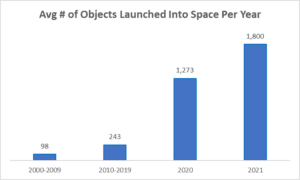January 25, 2022
Infrastructure, broadly, can be defined as the set of tools we use to run the world. More and more, those tools aren’t based here on Earth. They’re based in space, where they improve communications, monitor environmental conditions and help us navigate the world around us.
Humans have only been exploring space for a relatively short period of time. But the last few years have seen massive investments in space-based infrastructure for everything from GPS services to communications satellites to weather and disaster monitoring.
Just How Many Satellites Are There?
According to the UN Office of Outer Space Affairs, 1,674 objects were launched into orbit in 2021 alone, a figure that doesn’t include objects that launched into space but are not orbiting the Earth.
 In fact, the number of objects launched into space is increasing dramatically. Between 2000 and 2009, an average of 98 objects were launched into space each year, according to United Nations data. In the decade that followed, that figure more than doubled to an average of 243 objects each year. But the subsequent and most recent two years saw those figures rise dramatically, to 1,273 in 2020, and more than 1,800 in 2021.
In fact, the number of objects launched into space is increasing dramatically. Between 2000 and 2009, an average of 98 objects were launched into space each year, according to United Nations data. In the decade that followed, that figure more than doubled to an average of 243 objects each year. But the subsequent and most recent two years saw those figures rise dramatically, to 1,273 in 2020, and more than 1,800 in 2021.
Rapid Commercialization
More than 54% of U.S. satellites in operation are used for commercial purposes, according to data compiled by the World Economic Forum.
“The advent of commercial space operations has changed the growth curve of space operations,” said IEEE Senior Member Paul Kostek. “Long the domain of nations, space is now shared with companies that fly tourists into space, build satellite constellations, construct space stations and plan their own missions to the Moon and Mars. This transition has come quickly and faster than many thought it would. The willingness to invest private funds to build space launch capability will continue to expand human capability in space and also will require some planning on how space is managed.”
Private companies are planning to launch tens of thousands of Low Earth Orbit (LEO) satellites that will be used for internet, observation and communications. That will require greater cooperation among governments, and an update to the UN Outer Space Treaty, which is the only existing agreement managing the use of space.
“The satellites will also have to be monitored to ensure there are no collisions,” Kostek said. “Recently two satellites from a constellation came close to a national space station in development and required action to reduce the possibility of collision.”
Of course, the most common use of space-based services comes from one of the five major global navigation and satellite systems (GNSS) used for mapping and directions on our smartphones. In the U.S. the GNSS system is known as the global positioning system, but other nations have developed their own systems, including China’s BeiDou system, Russia’s Global Navigation Satellite System (GLONASS) system and the EU’s Galileo satellite constellation. Of these, the largest is the GPS, which operates roughly 30 satellites. Each system is also augmented by a number of space-based and ground-based technologies that improve accuracy.
Which is to say that, though most of us rely on GNSS systems, it’s but a small fraction of space-based infrastructure.
Emerging Applications
Other technologies are emerging. Companies across the world are racing to create satellite constellations that provide internet connectivity and other communications services, like 5G networks.
Satellites have traditionally been extremely expensive. On Earth, companies are using 3D printing to manufacture satellites for a fraction of the cost. A new generation of automated “space tugs” has emerged to deliver and position satellites in orbit for new communications constellations.
“So far, most of the revenues from commercial space exploration relate to goods and services produced in space for use on Earth-like satellite telecommunications, internet infrastructure, geo-referencing services and satellite launch services,” said Raul Colcher, IEEE Life Senior Member. “But there are signs that there will be, in a few years, the explosion of a new space economy, based on products and services produced and consumed outside the Earth. These include space tourism, mining on the moon, new materials, establishment of human settlements, support services and consumables designed to operate in a zero-gravity environment.”
If you are interested in learning more about the future of space travel, check out this video series, a joint collaboration of the IEEE Aerospace and Electronic Systems Glue Technologies for Space Systems Technical Panel and Professor Alessandro Golkar of the Skoltech Center for Entrepreneurship and Innovation.





 Meaningful Momentum or Running in Place?
Meaningful Momentum or Running in Place? AI Through Our Ages
AI Through Our Ages Liquid Infrastructure: Our Planet's Most Precious Resource
Liquid Infrastructure: Our Planet's Most Precious Resource The Impact of Technology in 2025
The Impact of Technology in 2025 Quantum and AI: Safeguards or Threats to Cybersecurity?
Quantum and AI: Safeguards or Threats to Cybersecurity? Why AI Can't Live Without Us
Why AI Can't Live Without Us Bits, Bytes, Buildings and Bridges: Digital-Driven Infrastructure
Bits, Bytes, Buildings and Bridges: Digital-Driven Infrastructure Impact of Technology in 2024
Impact of Technology in 2024 Emerging AI Cybersecurity Challenges and Solutions
Emerging AI Cybersecurity Challenges and Solutions The Skies are Unlimited
The Skies are Unlimited Smart Cities 2030: How Tech is Reshaping Urbanscapes
Smart Cities 2030: How Tech is Reshaping Urbanscapes Impact of Technology 2023
Impact of Technology 2023 Cybersecurity for Life-Changing Innovations
Cybersecurity for Life-Changing Innovations Smarter Wearables Healthier Life
Smarter Wearables Healthier Life Infrastructure In Motion
Infrastructure In Motion The Impact of Tech in 2022 and Beyond
The Impact of Tech in 2022 and Beyond Cybersecurity, Technology and Protecting Our World
Cybersecurity, Technology and Protecting Our World How Technology Helps us Understand Our Health and Wellness
How Technology Helps us Understand Our Health and Wellness The Resilience of Humanity
The Resilience of Humanity Harnessing and Sustaining our Natural Resources
Harnessing and Sustaining our Natural Resources Creating Healthy Spaces Through Technology
Creating Healthy Spaces Through Technology Exceptional Infrastructure Challenges, Technology and Humanity
Exceptional Infrastructure Challenges, Technology and Humanity The Global Impact of IEEE's 802 Standards
The Global Impact of IEEE's 802 Standards Scenes of our Cyber Lives: The Security Threats and Technology Solutions Protecting Us
Scenes of our Cyber Lives: The Security Threats and Technology Solutions Protecting Us How Millennial Parents are Embracing Health and Wellness Technologies for Their Generation Alpha Kids
How Millennial Parents are Embracing Health and Wellness Technologies for Their Generation Alpha Kids Space Exploration, Technology and Our Lives
Space Exploration, Technology and Our Lives Global Innovation and the Environment
Global Innovation and the Environment How Technology, Privacy and Security are Changing Each Other (And Us)
How Technology, Privacy and Security are Changing Each Other (And Us) Find us in booth 31506, LVCC South Hall 3 and experience the Technology Moon Walk
Find us in booth 31506, LVCC South Hall 3 and experience the Technology Moon Walk Virtual and Mixed Reality
Virtual and Mixed Reality How Robots are Improving our Health
How Robots are Improving our Health IEEE Experts and the Robots They are Teaching
IEEE Experts and the Robots They are Teaching See how millennial parents around the world see AI impacting the lives of their tech-infused offspring
See how millennial parents around the world see AI impacting the lives of their tech-infused offspring Take the journey from farm to table and learn how IoT will help us reach the rising demand for food production
Take the journey from farm to table and learn how IoT will help us reach the rising demand for food production Watch technical experts discuss the latest cyber threats
Watch technical experts discuss the latest cyber threats Explore how researchers, teachers, explorers, healthcare and medical professionals use immersive technologies
Explore how researchers, teachers, explorers, healthcare and medical professionals use immersive technologies Follow the timeline to see how Generation AI will be impacted by technology
Follow the timeline to see how Generation AI will be impacted by technology Learn how your IoT data can be used by experiencing a day in a connected life
Learn how your IoT data can be used by experiencing a day in a connected life Listen to technical experts discuss the biggest security threats today
Listen to technical experts discuss the biggest security threats today See how tech has influenced and evolved with the Games
See how tech has influenced and evolved with the Games Enter our virtual home to explore the IoT (Internet of Things) technologies
Enter our virtual home to explore the IoT (Internet of Things) technologies Explore an interactive map showcasing exciting innovations in robotics
Explore an interactive map showcasing exciting innovations in robotics Interactively explore A.I. in recent Hollywood movies
Interactively explore A.I. in recent Hollywood movies Get immersed in technologies that will improve patients' lives
Get immersed in technologies that will improve patients' lives